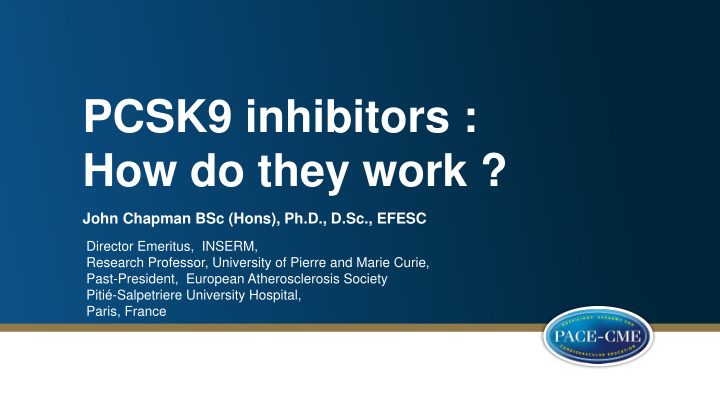



PCSK9 inhibitors : How do they work ? John Chapman BSc (Hons), Ph.D., D.Sc., EFESC Director Emeritus, INSERM, Research Professor, University of Pierre and Marie Curie, Past-President, European Atherosclerosis Society Pitié-Salpetriere University Hospital, Paris, France
Which factors are central to the physiological control of circulating LDL-C levels ? • LDL receptor • PCSK9 - (Proprotein convertase subtilisin kexin 9)
The cellular LDL receptor 2 3 4 5 6 EXONS DOMAINS DOMAINS I II III IV V VI VII NH 2 Ligand binding Ligand binding (292 aa) (292 aa) A B Epidermal growth factor precursor homology (400 aa) C O-linked sugars (58 aa) Membrane- spanning (22 aa) Cytoplasmic COOH (50 aa) http://www.iemrams.spb.ru/english/molgen/fh-en/domain-e.htm. [Accessed 6 August 2015]
LDL Receptor Function and Life Cycle
PCSK9: undergoes autocatalytic cleavage to take up its active conformation for LDLR binding Catalytic domain C-terminal Prodomain SP 692 D H S Autocatalytic cleavage Abifadel et al. (2003) Nat Genet 34:154
PCSK9 and the LDL Receptor Ligand-binding domain LDLR b propeller EGF-like repeats Catalytic domain Prodomain PCSK9 Carboxyl- terminus Horton JD, et al. J Lipid Res . 2009;50:S172-S177.
Role of PCSK9 in Regulation of LDL-R Expression
Absence of PCSK9 Leads to Marked Increase in LDL-R PCSK9 knockout mice : hepatic LDL-R levels Immunoblot Immunofluorescence against LDL-R PCSK9 decreases number of LDL-R : LDL-C Rashid S et al. PNAS 2005;102:5374 – 5379
Loss-of-Function PCSK9 mutations are associated with low LDL-C and low prevalence of CHD events 88% reduction in risk of CHD No nonsense 50 th Percentile events during 15-year follow-up 30 mutation Mean 138 mg/dL (n = 3278) 12 20 10 Coronary Heart Disease (%) 8 Frequency (%) 9.7% 0 0 50 100 150 200 250 300 PCSK9 142x or PCSK9 679X (n=85) 4 30 Mean 100 mg/dL (-28%) 20 10 1.2% 0 No Yes 0 PCSK9 142x or 0 50 100 150 200 250 300 PCSK9 679X Plasma LDL-C in black subjects (mg/dL) Adapted from Cohen JC et al. N Engl J Med 2006;354:1264 – 72.
• Individuals who completely lack PCSK9 and have very low LDL-C levels (approx. 15 mg/dL) are healthy • Therefore, inhibition of PCSK9 represents a safe pharmacologic approach to management of hypercholesterolemia and CVD prevention
Evolocumab and Alirocumab • Fully human PCSK9 monoclonal antibodies • Less likely to have immune side effects: - Neutropenia - Thrombocytopenia - Hemolytic anemia - Hypersensitivity reactions
Impact of an PCSK9 mAb on LDL Receptor Expression For illustration purposes only mAb
PCSK9 Inhibition by Monoclonal antibodies: Dynamic Relationship Between mAb Levels, PCSK9 and LDL-C 200 0 LDL-C 180 Free/total PCSK9 Conc. (ng/mL) Total alirocumab (ng/mL) X 0.01 -10 LDL-C mean % change 160 -20 140 PCSK9 mAb 120 -30 100 -40 80 60 -50 Total MAB 40 Free PCSK9 -60 LDL-C 20 0 -70 0 500 1000 1500 2000 2500 2 W Time (hours) Stein EA et al. New Engl J Med 2012;366:1108 – 18.
Mechanism of statin-mediated upregulation of the LDLR gene via SREBP2 LDL-C LDLR Lysosomal degradation Hepatocyte Statin SREBP2
Mechanism of statin-mediated upregulation of the LDLR and PCSK9 genes via SREBP2 LDL-C LDLR PCSK9 Lysosomal degradation Hepatocyte Statin SREBP2 Adapted from Konrad RJ, et al. Lipids Health Dis 2011;10:38.
Key Messages • MABs to PCSK9 efficaciously remove the target from plasma, resulting in enhanced LDL receptor numbers (espec. in liver). • Ag: Ab complex removal occurs primarily through the high capacity RES system, mainly in liver and spleen. • Circulating MAB levels directly determine plasma PCSK9 concentrations, and thence those of LDL-C. • The amount of the MAB injected can be increased to provide target saturation for up to one month with a single subcutaneous injection. • Genetically-determined absence of PCSK9 is not deleterious to health. • MABs to PCSK9 are typically used with concomitant statin therapy in very high risk patients, allowing 60% additional LDL-C reduction.
Recommend
More recommend